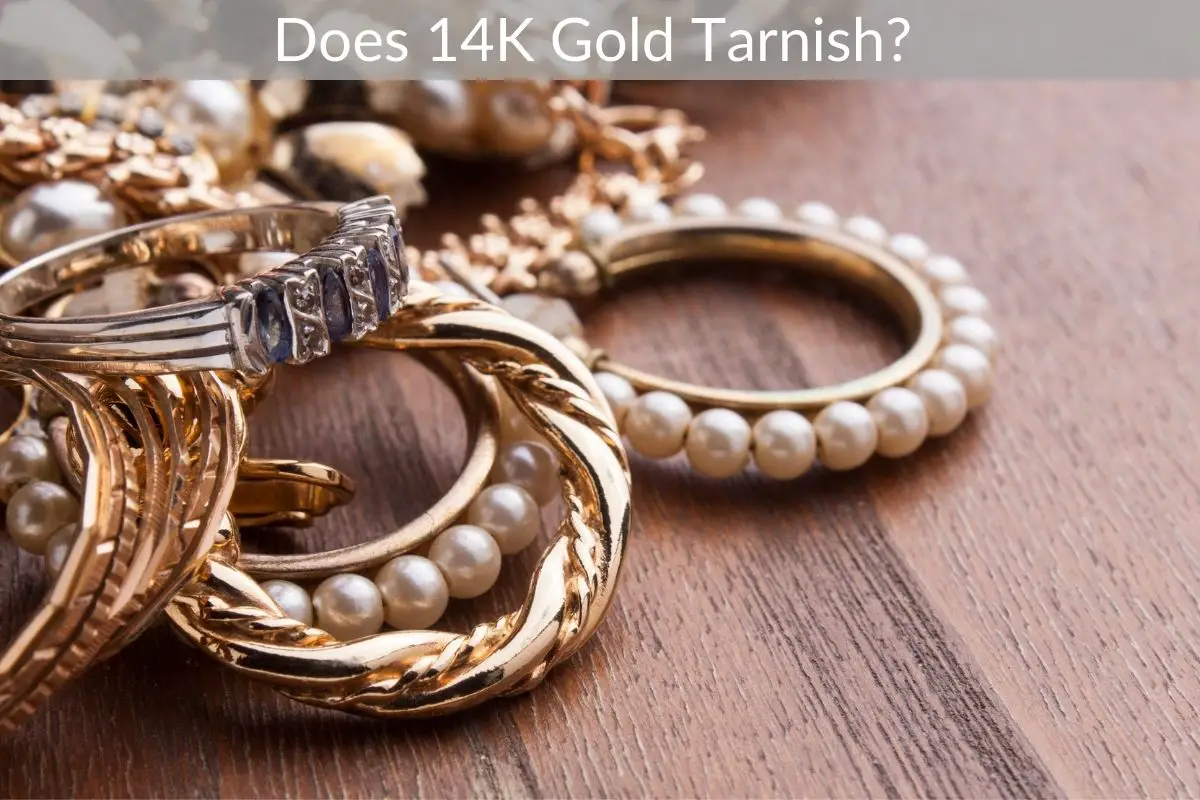Table of Contents
Do you like wearing rings?
*This post may contain affiliate links. As an Amazon Associate we earn from qualifying purchases.
If yes, are you wearing one right now?
Why not give the ring a closer look and tell us what you see.
- Are there are scratches on it?
- Does the ring look dull?
- Has it lost some of its shine?
- Is there a thin white film on and underneath it?
If you see all these signs, you, my friend, haven’t been taking good care of your gold ring!
You have heard that pure gold does not tarnish. So, by now, you are probably wondering if you are wearing a fake gold ring or not.
Well, don’t worry because we are 99% sure that your ring is not a knockoff. However, it is possible you were scammed into buying a 10K gold ring when you asked for 14K.
Now that you know gold is susceptible to tarnishing, let’s look at the matter in detail to determine why:
To see some of the most popular gold jewelry just click here.
Is Gold Jewelry Made of 100% Pure Gold?
No!
A gold ring does contain pure gold, but it also has different metals that give the jewelry strength. This mixture prevents it from bending and breaking. When it comes to 24K gold, it does not contain any types of alloys.
Below are the reasons why jewelry is not made with 24K gold:
- It’s Extremely Soft: Pure gold warps and bends easily in 24K form, which makes it a poor metal for jewelry. Since it does not retain its shape, it scratches easily. It becomes unattractive and scuffed quickly.
- It’s Very Bright: Pure gold has a sharp yellowish-orange color, which does not make it a pleasing for jewelry or watches.
- It’s Extremely Expensive: Since we are talking about pure gold and 0% alloys, 24K jewelry is extremely expensive. Not only is the metal expensive but the labor too. Since the gold is soft, it takes a lot of time to shape into a form.
The only thing pure gold is good for is investment. Since the price of gold keeps rising and will continue to, you can exchange it for cash for an emergency.
Why Does 14K Gold Tarnish?
Gold jewelry is made by mixing pure gold and alloys. Since pure gold is very soft, it needs to be mixed with other metals to produce strong jewelry. The following chart lists the purity of gold:
| Gold Karat (K) | Fraction of Gold | Gold Purity (%) | Millesimal Fineness |
| 9K | 9/24 | 37.5% | 375 |
| 10K | 10/24 | 41.7% | 416/417 |
| 12K | 11/24 | 50% | 500 |
| 14K | 12/24 | 58.3% | 583/585 |
| 18K | 18/24 | 75% | 750 |
| 22K | 22/24 | 91.7% | 916/917 |
| 24K | 24/24 | 99.9% | 999 |
As you can see, 24K is the purest form of gold. It is rare to find 24K jewelry, and jewelers seldom make it because it is malleable. 14K gold falls in the middle of the chart is preferred by many people. It contains the perfect ratio of pure gold and alloys, making it strong. However, this gold-alloy ratio does not stop 14K gold from tarnishing.
Keep in mind: The higher the gold content in the ring, the less it will tarnish. Based on this, the only gold jewelry that does not tarnish or get scratched is 22K and 24K.
Gold usually tarnishes when it is exposed to moisture and air. This oxidizes the alloys, which changes the look of the jewelry. This change is often referred to as patina. This gives the jewelry an aged look, which many people like. Others want to remove it and restore the original shine of their jewelry.
10K vs. 14K vs. 18K Gold
10K Gold
- Advantages: More durable than other gold types and very affordable.
- Disadvantages: Has a pale yellow color and can trigger metal allergies.
Jewelry made of 10K gold is very durable compared to other types of gold jewelry. It contains more than 50% alloys, which gives it strength. Technically, 10K gold is legally called gold, but you won’t find it in the displays of high-end jewelers.
Aesthetically, 10K gold looks pale, which some people like and others don’t. Though 10K gold is durable, it’s not a big enough advantage to negate that it can cause allergies. If you are allergic to zinc, iron, nickel, copper, or silver, we suggest you don’t buy 10K gold jewelry.
14K Gold
- Advantages: It is durable, has the perfect ratio of pure gold, and offers great value for money.
- Disadvantages: Expensive.
14K gold jewelry has more pure gold than alloys. This gold type is mostly used to make engagement rings. Jewelry made from 14K gold has a pleasing and rich color. Its classic look makes it a better choice than 18K gold. Compared to 18K gold, it is more affordable and less susceptible to tarnishing.
18K Gold
- Advantages: Looks great and is still a good option for jewelry compared to 22K and 24K gold.
- Disadvantages: Scratches easily and is more expensive than 14K gold.
The 75% ratio of pure gold in 18K gold jewelry makes it an expensive option. It has a richer yellow shade than 14K gold, which is pleasing to the eye. It’s not too bright but if you like a little bling, you should go with this gold.
However, 18K gold is not acceptable for everyday wear as it gets scratched easily. Though its shine does not fade away underwater, a minor mishap in the bathroom can completely change your ring’s look.
Conclusion
14K gold jewelry is susceptible to tarnishing because it contains a mixture of multiple alloys. Compared to 18K gold, it will last longer and maintain its appearance. Since 18K gold has a higher ratio of pure gold in it, it will bend easily. As for 10K gold, it is mostly used for imitation jewelry and can cause allergies, which does not make it a great option for engagement rings.
So, if you are planning to buy pure gold jewelry and you have a high budget, we suggest that you choose between 14K and 18K gold.




